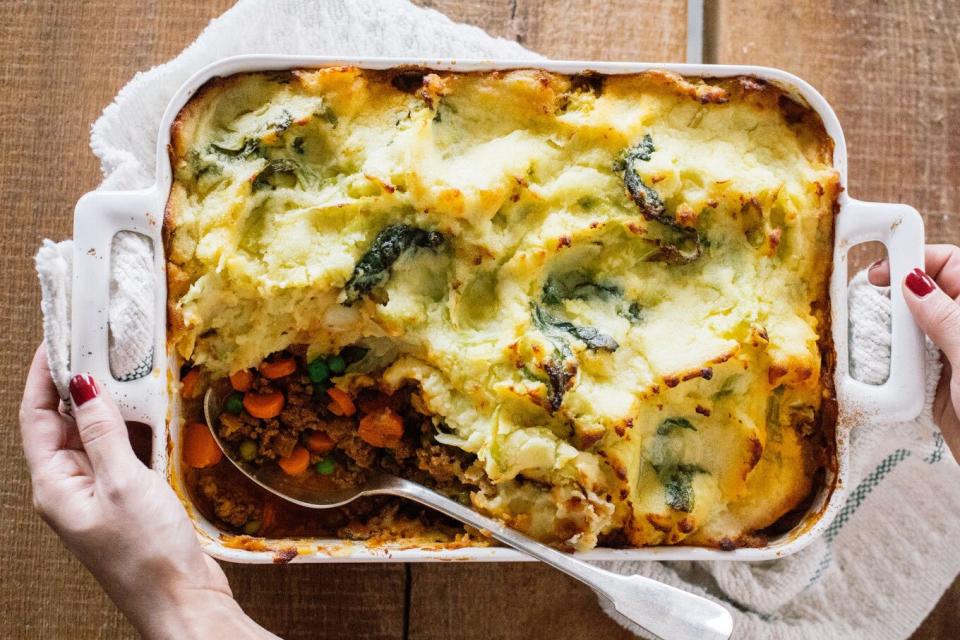What's the Best Type of Ground Beef to Use When Making Burgers, Lasagna, Chili, and More?
There's a lot to like about ground beef: It's versatile, economical, readily available, and easy, which makes it a great dinnertime option for busy families. But shopping for ground beef can be tricky, especially when you consider the plethora of different options available to you. At the supermarket, the meat section offers lots of variety, so which type should you you choose? Ultimately, it comes down to what recipe you're making. Our guide will help you make the right decision.
Related: Our Guide to Shopping for All Types of Meat

John Dolan
What Do the Labels Mean?
Buying ground beef sounds like it would be simple enough, but packages may also be labeled ground chuck, ground round, or ground sirloin; what's more, they usually offer a ratio of numbers which indicate lean versus fat. Here's the key to knowing which is which: 80-85 percent fat ground beef is from chuck primal cuts, 85-90 percent from the round, and 90 percent and leaner is derived from the sirloin. Each of the blends are ideal for different purposes.
Which Ground Beef Blend Should I Use?
Your goal should be flavorful and juicy meat, never greasy and bland. Nicole Rodriguez, a registered dietician nutritionist and certified personal trainer, says, "Many people prefer their burgers to be an 80/20 blend, 85/15 blend makes a tasty meatball or meatloaf, and 90 percent or leaner is great for sauces and crumbles. Any of the blends make a delicious chili, lasagna, baked ziti, and ground beef pairs perfectly with a variety of vegetables."
Sure, it's rich and delicious, but ground beef is also an excellent source of protein. "You might not think of ground beef as an add-in to pasta, but there's nothing quite like ground beef with some Greek seasoning, feta, spinach, sun dried tomatoes, and kalamata olives," says Rodriguez. "Beef really amps up the nutrient density of carb-rich meals, and helps stretch them out across more servings. A win-win!"
What's Best for Burgers?
When it comes to making hamburgers, Rodriguez is a fan of 80/20. "Any blend, whether 80/20 or on leaner side, is going to provide the unmistakable flavor and satisfaction of beef. If I'm being honest, nothing beats the eating experience of a burger made with an 80/20 blend. It's the juiciest especially when you allow the patties to rest for five minutes before serving," she says.
Buying and Storing
You may find organic and grass-fed ground beef at your supermarket. Rodriguez points out that both grass-fed and conventional grain-fed beef are nutritionally dense with a similar nutritional profile. While all beef is high in B12, B3, B6, iron, selenium, and zinc, grass fed is higher in vitamins A and E and offers a different composition of beneficial fatty acids such as Omega-3 and conjugated linoleic acid.
Select beef with a bright cherry-red color. Lack of oxygen turns the beef brown and can indicate that it is beginning to spoil. Choose packages without excessive liquid and avoid cross contamination by keeping raw ground beef and meat juices away from other foods, both in the refrigerator and during preparation. Because ground beef is more perishable than roasts or steaks, plan to use refrigerated ground beef within one to two days of purchase or store it in the freezer where it will keep for three to four months.
Cooking Tips
Use a gentle touch when preparing ground beef. Over-mixing will result in burgers, meatballs, or meatloaves with a firm, dense texture. And remember tat cooking ground beef with high heat can nicely sear the outside, but it can also overcook or char the outside while the interior remains underdone.

